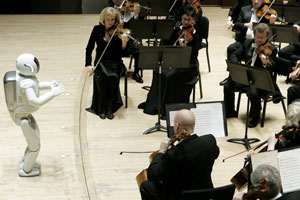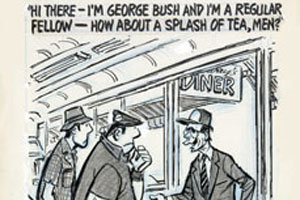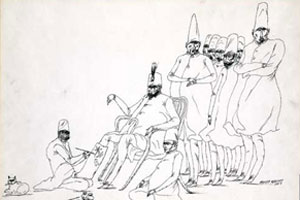Focus on America
A Robot Conducts the Detroit Symphony Orchestra

The ranks of orchestra conductors have included such esteemed figures as composers Hector Berlioz and Leonard Bernstein, opera singer Placido Domingo, and musicians Leonard Slatkin and Mstislav Rostropovich. Now they are joined by Asimo, a humanoid robot.
A humanoid robot mimics the human body in its appearance and actions. It has a torso, head, legs, arms, and hands and fingers. Asimo -- the name is an acronym for Advanced Step in Innovative Mobility -- is one of the most advanced humanoid robots. It is capable of walking, running, recognizing moving objects and faces, posturing and gesturing, distinguishing sound and -- as it turns out -- conducting orchestras.
Asimo’s debut performance was May 13 at the Detroit Symphony Orchestra, where it conducted a performance of “The Impossible Dream,” a song from the musical Man of La Mancha. Since Asimo stands only 1 meter 30 centimeters high, acclaimed cellist Yo-Yo Ma, who also performed that evening, had to stoop to shake its hand.
The audience’s response was enthusiastic, but the musicians in the orchestra had mixed feelings. Some commented on how fluid and humanlike Asimo’s gestures were, yet others felt the robot still lacked a humanlike quality. French horn player David Everson said on National Public Radio: "You can't see its eyes. They can't convey any kind of emotions to you. … It's standing up there; it's not moving forward; it's not moving back. It's not making little small gestures or giving anybody any cues.”
Leonard Slatkin, music director of the Detroit Symphony Orchestra, indicated he wasn’t worried that robots will take over conducting music anytime soon. He said a robot like Asimo cannot improvise on the spur of the moment, something that conductors have to be able to do to truly lead an orchestra.
Asimo’s other artistic endeavors include dancing at February’s “Japan! Culture + Hyperculture” festival at the John F. Kennedy Center for the Performing Arts in Washington. The festival also featured a trumpet-playing humanoid, the Toyota Partner Robot.
Humans are accustomed to robots assembling cars or packaging manufactured goods, but current advances in robotics have resulted in robots performing tasks that traditionally have been the domain of humans.
Asimo is programmed to perform some tasks of a receptionist, information guide and delivery service automatically. It also can function in an office environment and move in concert with humans while accommodating their movements. Robots have also helped millions of people with tasks such as vacuuming, cleaning swimming pools, washing floors and cleaning gutters. Robots also tackle tasks that are dangerous for people, like defusing bombs and fighting fires.
In popular literature and film, robots have been associated with artificial intelligence. Conscious robots that function autonomously are still in the realm of science fiction. However, the debate about the possibilities of artificial intelligence and robotics is useful in preparing societies for future decisions about robots.
As labor costs increase, and as innovations in robotics continue, the applicability of robots in daily life will increase. So don’t be surprised if you interview for a job one day and find a friendly robot receptionist greeting you at the door!
Recently on Focus on America
Political Cartoonist Herblock Skewered the Powerful
 To friends and acquaintances, Herbert L. Block (1909-2001) was an unassuming man with a gentle demeanor, but to U.S. presidents from the 1930s to the 1990s he was a scourge who wielded his wit like a blunt instrument, often at their expense.
To friends and acquaintances, Herbert L. Block (1909-2001) was an unassuming man with a gentle demeanor, but to U.S. presidents from the 1930s to the 1990s he was a scourge who wielded his wit like a blunt instrument, often at their expense.
New York City Museum Exhibits Drawings by Iranian Satirist
 “I do not believe in an ideal society. I do not need an ideal society, either, as there is no need for me in such a society. If someday I feel the need for an ideal society, I will rent one.” -- Ardeshir Mohassess, in conversation with journalist Amir Teheri, 1971
“I do not believe in an ideal society. I do not need an ideal society, either, as there is no need for me in such a society. If someday I feel the need for an ideal society, I will rent one.” -- Ardeshir Mohassess, in conversation with journalist Amir Teheri, 1971
What’s next for Michael Phelps?
 With his record-braking eight Olympic gold medals won during the 2008 Beijing Olympics, Michael Phelps arguably became the greatest Olympian of all time this week.
With his record-braking eight Olympic gold medals won during the 2008 Beijing Olympics, Michael Phelps arguably became the greatest Olympian of all time this week.